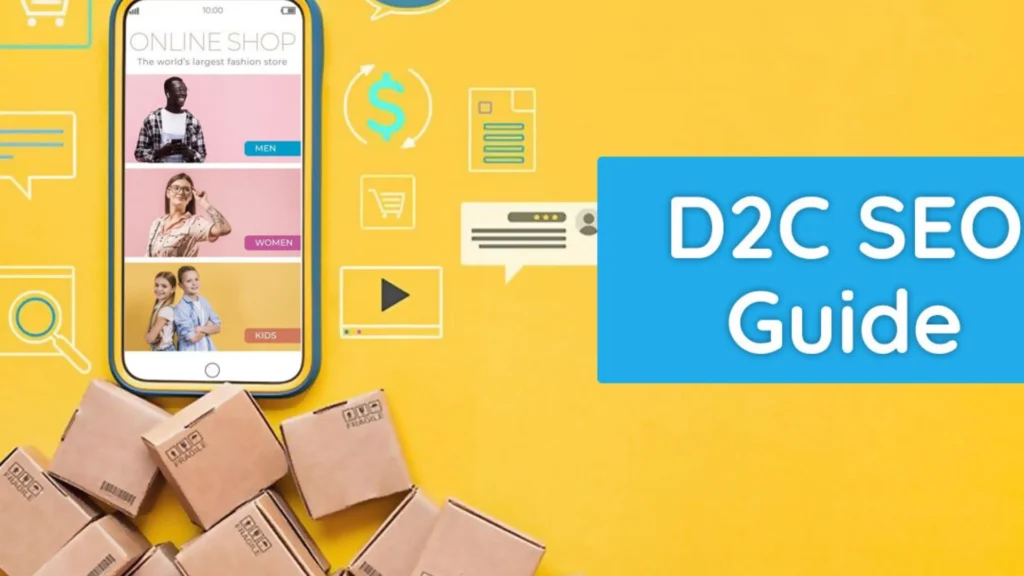D2C brands thrive or fail based on how easily customers can find them. If people can’t locate your products when they search, your ads will cost more, your profits will shrink, and your growth will slow down. This is where clever SEO steps in: when done , it generates steady organic demand, cuts down reliance on paid channels, and builds value over time.
Here’s a practical strategic guide of D2C brand SEO tips — steps you can take this month, ideas for measuring success supporting facts, and upcoming trends to get ready for.
Why is SEO crucial for D2C brands?
- Organic search continues to be a key way for online stores to get customers: many shops see a big chunk of their website visits and a good portion of their sales come from organic search — putting effort into SEO means investing in long-term visibility.
- The direct-to-consumer market is big and keeps growing: D2C e-commerce sales in the U.S. reach hundreds of billions, and the global D2C market is expected to grow by double digits year over year, so there’s a real chance to grab a piece of the organic search pie.
These two facts show that your SEO work builds on itself: each helpful article, tech fix, and structured data update makes it easier for people to find you in the future.
Key D2C brand SEO tips: Checklist that works
1) Begin with research on keywords showing buyer intent
Skip starting with “shoes” or “organic serum.” Instead chart your funnel and identify the keywords buyers use at each step:
- Awareness: “how to treat dry skin”
- Consideration: “best serums for skin hydration”
- Purchase: “hydrating serum 30ml buy online”
Prioritize based on search volume + intent + conversion indicators (internal search, Google Analytics behavior). Put your efforts into pages that can bring in qualified traffic and lead to sales.
2) Product pages: boost both conversion and discoverability
Think of product pages as sales tools and SEO assets at the same time.
- Title tags: put the product name + 1–2 key features (size, color main benefit).
- H1 and opening paragraph: match the title but add a sentence about why this product matters.
- Descriptions: skip supplier copy. Create unique, benefit-focused descriptions that address user questions and use natural relevant keywords.
- Structured data: add Product schema (price, availability, reviews) to enable rich results.
- Internal linking: connect from category pages, blog posts, and related products to boost relevance.
Technical speed is crucial: quicker product pages sell better — treat page speed and core web vitals as ways to improve conversion, not just SEO.
3) Make category pages into discovery hubs
Category pages should do more than just filter. Each main category needs:
- A unique helpful intro (100–300 words) that explains who the collection is for and uses search terms in a natural way.
- Filtered content indexed in a sensible way — don’t index duplicate category pages with tiny differences. Use canonical tags, noindex where it makes sense, and a clear breadcrumb structure.
- Smart management of faceted navigation — keep search engines focused on crawling valuable pages.
4) Content that zeros in on micro-moments
Create content that answers real customer problems: how-tos, comparison pieces, “best of” lists sizing guides, and care instructions. These are the pages that:
- Show up for specific detailed searches,
- Get backlinks from bloggers and news sites, and
- Reach potential buyers in their shopping journey.
For direct-to-consumer brands, content that answers questions after purchase (like how-to guides) works best — these pages keep customers interested and lead to fewer returns.
5) Let product research and user behavior guide your content
Look through site searches, customer service chats, and reviews to find the exact words customers use. Put those words in headings, FAQs, and structured data. This simple step can boost relevance and click-through rates.
6) Reviews, user-generated content, and social proof
Customer reviews do more than provide social proof. They create unique, keyword-rich content and boost click-through rates. Push for verified reviews, show them on product pages, and tag them with Review schema to qualify for rich snippets.
7) Technical SEO: crawlability, indexation, and mobile first
A quick technical audit checklist:
- Make sure your site renders mobile-first and uses responsive templates.
- Make the most of your crawl budget: Keep XML sitemaps accurate, clean up robots.txt, and don’t index low-value filter pages.
- Fix broken links and redirect chains.
- Check that canonical URLs are right for variants and tracking parameters.
- Keep an eye on Core Web Vitals and CLS to protect rankings and conversion. Page speed affects e-commerce results.
8) International and vernacular SEO
If you do business in multiple markets, make sure to use hreflang correctly, customize product descriptions for each locale (don’t just rely on machine translation), and include local payment and shipping details on your pages. In countries like India local language search and chat apps play a key part in direct-to-consumer growth — adjust your content and search strategy to fit these needs.
9) Structured data and AI-friendly content
Add Product Review, Breadcrumb, FAQ, and HowTo schema where it makes sense. As AI shopping helpers and new search tools pop up clear data and signals help search engines and AI understand and show your products. Recent changes in how people shop mean brands with clean product info will get more attention.
10) Building links that matter and add value
Quality is better than quantity. For D2C, the best link chances come from:
- Niche writers and bloggers making product lists,
- Content with data or new research that gets links,
- Working with partners and other brands, and
- Getting press for new products or seasonal trends.
Focus on relevant topics — a few high-quality links from trusted sites in your field have more impact than loads of poor-quality links.
Measurement: what to track and why
- Organic sessions and new users (overall health).
- Branded vs. non-branded organic traffic (shows if you’re reaching new audiences).
- Conversions and assisted conversions from organic (revenue credit).
- Rankings for keywords showing buying intent.
- Time on page, bounce rate, and on-site search queries (how useful your content is).
- Page speed/Core Web Vitals (technical health).
- Crawl errors, indexation counts, and coverage issues in Search Console.
Look at the numbers to set your priorities: if a category brings in 30% of sales but gets 5% of natural search traffic, that’s where improving things will pay off.
What are the Advanced D2C brand SEO tips?
Making things personal for lots of people based on what they do on your site
Use how people act (what they’ve bought before, what they look at) to show them category pages and content they’ll like. Making things personal leads to more sales and fewer returns — pair this with SEO by using main URLs and creating personalized parts on the server so pages can still be found by search engines.
Make your site better for picture and video searches
A lot of product searches start with pictures or short clips. Add thorough alt text descriptive file names, and organized data for videos. Put short product demos and how-tos on your product pages and YouTube — having videos boosts your spot in search results.
Get ready for searches led by AI and conversations
As AI shopping helpers and voice assistants become widespread, tweak your product descriptions for natural language questions and include clear details (what it’s made of, how big it is, how long shipping takes). Organized data and FAQ sections match up well with what these helpers say. Brands that make product info easy to understand will show up more often in these helpers’ responses.
Use your own data without hurting SEO
As third-party cookies lose ground, focus on building first-party signals: track website behavior, measure email engagement, and note logged-in user preferences. These signals help create better landing pages and shape keyword and content plans — while keeping pages easy to crawl and index.
Quick technical wins every D2C should tackle this month
- Check and fix any redirect chains.
- Add Product and Review schema to top 100 SKUs.
- Write 2 buyer-intent blog posts that link to product pages.
- Cut down Largest Contentful Paint on product pages to under 2.5s.
- Set up or tidy up canonical tags for variant pages.
Future trends every D2C brand should get ready for
1) AI shopping helpers change product discovery
AI assistants are starting to search, compare, and even buy things for users. This changes how SEO works: companies need to provide easy-to-read product info, clear descriptions, and stand-out features so these helpers pick their products.
2) Super-tailored and instant experiences
Get ready for more website customization based on tiny clues: where you are, what device you’re using, what you’ve bought before, and how you’re browsing right now. SEO needs to work well with this tailoring — keep main versions of pages that search engines can find, while using changeable parts for customization.
3) More visual and video searches
Customers will search for similar items using pictures and brief videos. To boost visibility in search results and social platforms, brands should enhance their visual content and create helpful short demos (30-60 seconds).
4) Local and everyday language search (key in big markets)
In areas with multiple languages, everyday language queries and chat apps (like WhatsApp for shopping) will fuel direct-to-consumer growth. To cut down on hassles, make sure not just the writing, but also the payment and delivery experiences are tailored to each location.
5) Privacy, data changes, and first-party plans
As privacy rules change, building direct connections with customers through email, loyalty programs, and logged-in experiences will become more crucial. SEO should be part of a well-rounded first-party plan: use search to attract visitors then get their email or sign-ups to create your own first-party data cycle.
How to build your SEO plan (90-day strategy)
Month 1 — Check & fix
- Fix tech SEO and speed issues, set up basic schema, clean up sitemap & robots.
- Find 20 pages with high potential to improve.
Month 2 — Write & tweak pages
- Create 4 pieces of content for high-intent searches, improve top category and product pages.
- Start asking customers for reviews.
Month 3 — Expand & track
- Reach out for links to 2 key content pieces, create dashboards to track organic revenue, and try personalization tests.
Keep repeating: checks, content, and outreach are key to growing organic traffic.
Why D2C brands that invest in SEO win long term
Paid channels can grow fast but cost more as time passes; SEO builds up. It reduces acquisition cost, boosts customer lifetime value (by drawing in relevant high-intent traffic), and creates brand authority that outlasts ad budgets.
Why Choose Modifyed Digital as Your D2C Brands Agency?
Modifyed Digital partners with D2C brands to grow predictable scalable organic channels. We blend thorough technical SEO, conversion-focused on-page improvements, and original content that turns browsers into buyers. What sets Modifyed Digital apart for D2C:
- We craft SEO plans around important SKUs — the products that boost margin and keep customers — not just surface-level metrics.
- We link content to buying plans: product info, comparison guides, and after-purchase content that cuts returns and boosts repeat buys.
- We set up strong product data and layouts to make sure products show up in normal search, picture results, and new AI-guided interfaces.
- We mix SEO with CRO and email kickoffs so organic traffic starts making money right away.
If you need a team that gets product sales, work limits, and the creative stuff to get links and press, Modifyed Digital is ready to grow D2C brands in ways you can measure.
FAQs
- What are the best SEO methods for D2C brands?
Meta description: Find out the top SEO techniques for D2C brands — from making product pages better to creating content that sells and fixing technical issues to boost organic sales.
- How soon will SEO affect D2C sales?
Meta description: Learn realistic timeframes for D2C SEO outcomes, what you should track, and how to get faster returns by focusing on quick fixes and content.
- Should D2C brands use content marketing or paid ads?
Meta description: Get to know when to focus on SEO-driven content vs. paid ads for D2C growth, and how to use both together to maximize customer value over time.
- How do AI shopping agents have an impact on D2C SEO strategy?
Meta description: Find out how AI agents are shaking up product discovery and the actions D2C brands need to take — structured data, clear product descriptions, and semantic cues — to remain visible.
Also Read:
Retention marketing strategy for D2C brands






